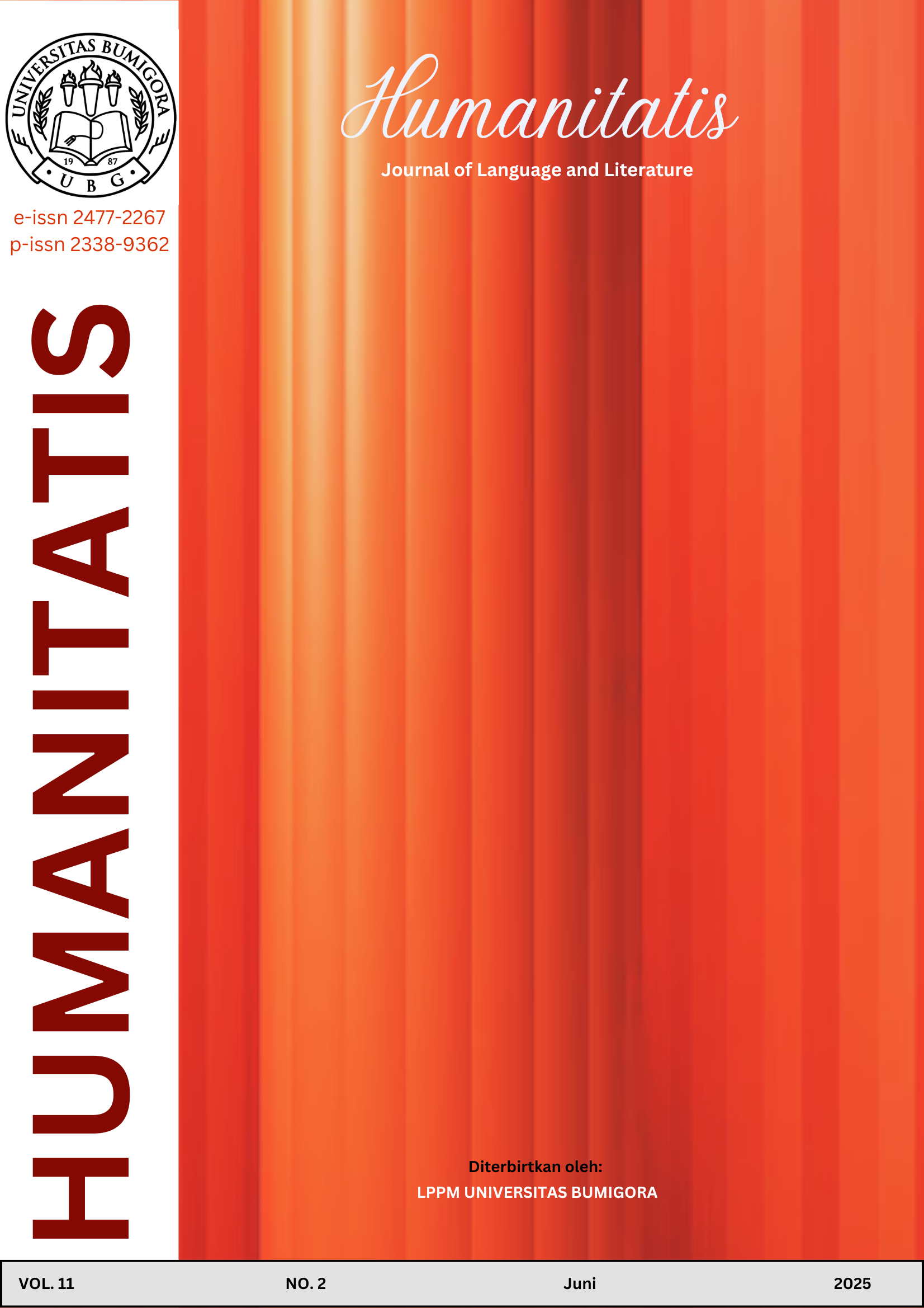Ideology and Communication Strategy of Indonesia’s 2024 Presidential Candidates: A Transitivity Analysis
DOI:
https://doi.org/10.30812/humanitatis.v11i2.4996Keywords:
Communication Strategy, Systemic Functional Linguistics, Critical Discourse Analysis, Political Discourse, TransitivityAbstract
The purpose of this study is to investigate presidential candidates’ ideologies and strategies of communication though the type of transitivity processes in their speech on the last presidential debate. The final debate of presidential candidates in 2024, all Candidates used languages to shape public opinion and persuade the audience. Critical discourse analysis (CDA) reveals hidden meanings or agenda of the candidates in debate. It examines how language supports power dynamics, social hierarchies, and ideologies. Those are expressed through text and speech in social and political contexts. The method used in this research is descriptive qualitative. The research began with the observation of the speeches of the candidates on an official video. Secondly, the data was subjected to a critical discourse analysis. This analysis was used to determine how the candidates presented themselves in terms of their different and common ideologies. The research findings revealed that six types of transitivity processes were found in the candidates’ speeches, with material processes dominating and then there was also a structural analysis that revealed that all candidates used different types of processes to display their respective leadership styles. Each Candidate’s reveals different ideologies, language patterns and political communication strategies that boosts persuasive and reveals the link between language, power, and ideology. It shows how all candidates create messages that resonate with voters, influencing public opinion and prompting action. Furthermore, the result of this research is to provide insight into the linguistic construction of political ideology and power in Indonesian political
discourse.
References
Agbo, I. I., Ngwoke, F. U., & Ijem, B. U. (2019). Transitivity processes in President Buhari’s “My Covenant With Nigerians.” English Language Teaching, 12(4), 7. https://doi.org/10.5539/elt.v12n4p7
Alhumsi, M. H., & Alsaedi, N. S. (2023). A transitivity analysis of two political articles: An investigation of gender variations in political media discourse. World Journal of English Language, 13(6), 107. https://doi.org/10.5430/wjel.v13n6p107
Almahasees, Z., & Mahmoud, S. (2022). Persuasive strategies utilized in the political speeches of King Abdullah II: A critical discourse analysis. Cogent Arts & Humanities, 9(1), 2082016. https://doi.org/10.1080/23311983.2022.2082016
Baldwin, J. (2018). Re-motivating Monroe, Click-Whirr: Social suasion and the motivated sequence. In The handbook of communication training. Routledge.
Creswell, J. W. (2014). Research design: Qualitative, quantitative, and mixed methods approaches (4th ed.). SAGE.
Fairclough, N. (2013). Critical discourse analysis: The critical study of language (2nd ed.). Routledge.
Gunawan, F., Kuraedah, S., Amir, A. M., Ubaidillah, M. F., & Boulahnane, S. (2023). Transitivity and critical discourse analysis on a testament: A woman’s involvement in jihad. Studies in English Language and Education, 10(1), 517–536. https://doi.org/10.24815/siele.v10i1.26330
Guswita, K. A., & Suhardi, S. (2020). Transitivity analysis of Jokowi and Prabowo campaign speech in Indonesian presidential election 2019. Indonesian Journal of EFL and Linguistics, 5(1), 143–159. https://doi.org/10.21462/ijefl.v5i1.234
Halliday, M. A. K., & Matthiessen, C. M. I. M. (2014). An introduction to functional grammar (3rd ed.). Routledge.
Hasanah, U., Alek, A., & Hidayat, D. N. (2019). A critical discourse analysis of RM’s speech. Jurnal Humaniora Teknologi, 5(2), 16–26. https://doi.org/10.34128/jht.v5i2.60
Haugen, J., & Lucas, K. (2019). Unify and present: Using Monroe’s Motivated Sequence to teach team presentation skills. Communication Teacher, 33(2), 112–116. https://doi.org/10.1080/17404622.2018.1502886
Kristina, D. (2020). Analisis wacana kritis pengantar praktis. Pustaka Pelajar.
Kurudayioğlu, M., & GocıAoğlu, B. (2021). İkna edici konuşma becerisinin geliştirilmesinde Monroe’nun motive edilmiş dizisi tekniği. Ana Dili Eğitimi Dergisi, 9(2), 314–329. https://doi.org/10.16916/aded.859485
Li, T., & Zhang, Y. (2019). Language and power: A critical discourse analysis of the political speech. International Journal of Languages, Literature and Linguistics, 5(4), 259–262. https://doi.org/10.18178/ijlll.2019.5.4.238
Martika, D., Mahyuni, M., & Azis, A. D. (2022). Critical discourse analysis of Barack Obama speech. Jurnal Ilmiah Profesi Pendidikan, 7(2c), 1020–1031. https://doi.org/10.29303/jipp.v7i2c.659
Mekt, Y., Getahun, A., & Meseret, T. (2024). A critical discourse analysis (CDA) of a political speech of Mr. Christian Tadele speech in the parliament. Journal of Education, Social & Communication Studies, 1(2), 56–62. https://doi.org/10.58881/jescs.v1i2.16
Micciche, T., Pryor, B., & Butler, J. (2000). A test of Monroe’s Motivated Sequence for its effects on ratings of message organization and attitude change. Psychological Reports, 86(3_suppl), 1135–1138. https://doi.org/10.2466/pr0.2000.86.3c.1135
Miles, M. B., & Huberman, A. M. (1994). Qualitative data analysis: An expanded sourcebook (2nd ed.). Sage.
Salih, R. H. (2019). Transitivity and mystification in a contemporary discourse analysis of Trump’s inaugural address. Theory and Practice in Language Studies, 10(1), 26–32. https://doi.org/10.17507/tpls.1001.04
Santoso, D., & Aji, A. S. (2021). Critical discourse analysis on Joko Widodo’s speech using Thomas N. Huckin’s theory. The 1st International Conference on Research in Social Sciences and Humanities (ICoRSH 2020), 886–894. https://doi.org/10.2991/assehr.k.211102.120
Saragih, A., Khairina, Y., & Batubara, K. B. (2024). Political contestation: Ideology and linguistic realization by 2024 prospective Indonesian presidential candidates. JOALL (Journal of Applied Linguistics and Literature), 9(1), 182–200. https://doi.org/10.33369/joall.v9i1.31677
Setiawan, I., Laksana, I. K. D., Mahyuni, M., & Udayana, I. N. (2018). System of modality on the text of Indonesian presidential candidates debate on the period of 2014–2019. International Journal of Social Sciences and Humanities, 2(1), 157–170. https://doi.org/10.29332/ijssh.v2n1.121
Supatmiwati, D., Dwiprasetyo, B. S., & Dewi, P. (2022). A transitivity analysis on Epic Rap Battle of Presidency song. Humanitatis: Journal of Language and Literature, 8(2), 217–226. https://doi.org/10.30812/humanitatis.v8i2.1843
Supatmiwati, D., Manda, M. L., Saleh, N. J., & Makka, M. (2020). Mood and modality analyses in investigating ideology of news about Indonesia in BBC World Webnews. ELS Journal on Interdisciplinary Studies in Humanities, 3(3), 408–414. https://doi.org/10.34050/elsjish.v3i3.11238
Syah, S. P. (2024). A multimodal critical discourse analysis on political speech by presidential candidate for the Republic of Indonesia 2024. Suar Betang, 19(1), 29–46. https://doi.org/10.26499/surbet.v19i1.14721
Thahara, Y., Firdaus, A. Y., Amelia, F., Lailiyah, S., Novitasari, N. F., Mila, D. T., & Khissoga, R. H. (2024). Attitude and political ideology of 2024 Indonesian presidential candidates reported in Jakartapost.com. Register Journal, 17(1), 123–145. https://doi.org/10.18326/register.v17i1.123-145
Thompson, G. (2013). Introducing functional grammar (3rd ed.). Routledge.
Tian, L. (2021). Critical discourse analysis of political discourse—A case study of Trump’s TV speech. Theory and Practice in Language Studies, 11(5), 516–520. https://doi.org/10.17507/tpls.1105.08
Tsunoda, T. (1985). Remarks on transitivity. Journal of Linguistics, 21(2), 385–396.
Van Dijk, T. A. (1993). Principles of critical discourse analysis. Discourse & Society, 4(2), 249–283. https://doi.org/10.1177/0957926593004002006
Wahyuni, R., & Syamsi, K. (2021). The analysis of critical discourse analysis in the speeches of Nadiem Makariem and Muhadjir Effendy at Teacher’s Day. International Journal of Linguistics, Literature and Translation, 4(6), 245–251. https://doi.org/10.32996/ijllt.2021.4.6.29
Wang, J., & Jin, G. (2022). Critical discourse analysis in China: History and new developments. In Oxford research encyclopedia of linguistics. https://doi.org/10.1093/acrefore/9780199384655.013.909
Wulansari, A., & Mazid, S. (2024). Revealing the ideology of documentary film Dirty Vote: Critical discourse analysis with transitivity perspective. Metathesis: Journal of English Language, Literature, and Teaching, 8(1), 43–58. https://doi.org/10.31002/metathesis.v8i1.1441
Yang, Y. (2023). Ideology in critical discourse study: A review of literature. Journal of the University of Ruhuna, 11(2), 53–63. https://doi.org/10.4038/jur.v11i2.8012
Downloads
Published
Issue
Section
License
Copyright (c) 2025 Diah Supatmiwati, Hilda Hastuti, Indra Indra, Annisa Fissilmi, Zuhroni, Tiara Resta Putri

This work is licensed under a Creative Commons Attribution 4.0 International License.
















